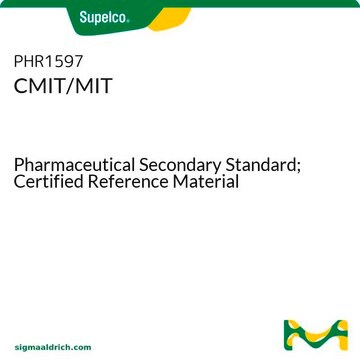SBR00032
MIT HCl Ready Made Solution
95 mg/mL in water (9.5%)
Sinonimo/i:
2-Methyl-1,2-thiazol-3-one, Methylisothiazolinone HCl, Methylisothiazolinone hydrochloride
About This Item
Prodotti consigliati
Forma fisica
liquid
Livello qualitativo
Concentrazione
95 mg/mL in water (9.5%)
Spettro attività antibiotica
Gram-negative bacteria
Gram-positive bacteria
Modalità d’azione
protein synthesis | interferes
Temperatura di conservazione
2-8°C
InChI
1S/C4H5NOS.ClH/c1-5-4(6)2-3-7-5;/h2-3H,1H3;1H
SJXPQSRCFCPWQQ-UHFFFAOYSA-N
Cerchi prodotti simili? Visita Guida al confronto tra prodotti
Descrizione generale
Applicazioni
- in research on the effects of the N-methyl D-aspartate (NMDA) receptor antagonist kynurenic acid on human cortical development [1]
- as a cytotoxic substance to investigate its effect on bronchial epithelial cells (BEAS-2B cells) and role in apoptotic cell death(2)
- to research the effects of tyrosine phosphorylation on focal adhesion kinase (FAK) activity in the development of neural axons and dendrites(3)
Azioni biochim/fisiol
Activity Spectrum: Active against Gram-positive and Gram-negative bacteria, as well as fungi, when used in combination with methylchloroisothiazolinone (MCI)
Caratteristiche e vantaggi
- Ready available solution reduce the need for preparation time
- Commonly used in Cell Biology and Biochemical applications
- High quality antibiotic suitable for mulitple research applications
Altre note
Prodotti correlati
Avvertenze
Danger
Indicazioni di pericolo
Consigli di prudenza
Classi di pericolo
Acute Tox. 4 Oral - Aquatic Chronic 2 - Eye Dam. 1 - Skin Corr. 1A - Skin Sens. 1
Rischi supp
Codice della classe di stoccaggio
8B - Non-combustible corrosive hazardous materials
Classe di pericolosità dell'acqua (WGK)
WGK 3
Punto d’infiammabilità (°F)
Not applicable
Punto d’infiammabilità (°C)
Not applicable
Certificati d'analisi (COA)
Cerca il Certificati d'analisi (COA) digitando il numero di lotto/batch corrispondente. I numeri di lotto o di batch sono stampati sull'etichetta dei prodotti dopo la parola ‘Lotto’ o ‘Batch’.
Possiedi già questo prodotto?
I documenti relativi ai prodotti acquistati recentemente sono disponibili nell’Archivio dei documenti.
Il team dei nostri ricercatori vanta grande esperienza in tutte le aree della ricerca quali Life Science, scienza dei materiali, sintesi chimica, cromatografia, discipline analitiche, ecc..
Contatta l'Assistenza Tecnica.









